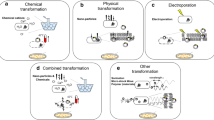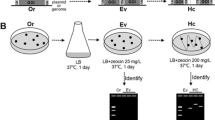Summary
The leading region of the Escherichia coli K12 F plasmid is the first segment of DNA to be transferred into the recipient cell during conjugal transfer. We report the nucleotide sequence of the 64.20–66.77F portion of the leading region immediately adjacent to the origin of transfer, oriT. The 2582 by region encodes three open reading frames, ORF95, ORF169 and ORF273; the product of ORF273, is equivalent in size and map location to the 35 kDa protein, 6d, previously described (Cram et al. 1984). S1 nuclease analyses of mRNA transcripts have identified a potential promoter for ORF95 and ORF273 and indicated that these ORFs are transcribed as a single transcript; in contrast, ORF169 appears to be transcribed from two overlapping promoters on the complementary DNA strand. The products of ORF95 and ORF273 are mainly hydrophilic and are probably located in the cytoplasm. ORF273 shares some homology with DNA-binding proteins. There is a signal peptide sequence at the NH2-terminus of ORF169 and the mature form of ORF169 probably resides in the periplasm due to its hydrophilic nature. Both ORF273 and ORF169 are well conserved among conjugative F-like and a few non-F-like plasmids. On the other hand, ORF95 sequences are only present on some of these plasmids. Several primosome and integration host factor recognition sites are present implicating this region in DNA metabolism and/or replication functions.
Similar content being viewed by others
References
Achtman M, Willetts N, Clark AJ (1971) Beginning a genetic analysis of conjugational transfer determined by the F factor in Escherichia coli by isolation and characterization of transfer-deficient mutants. J Bacteriol 106:529–538
Bergquist PL (1988) Incompatibility. In: Hardy KG (ed) Plasmids: A practical approach. IRL Press, Washington DC, pp 37–78
Bergquist PL, Lane HED, Malcolm L, Downard RA (1982) Molecular homology and incompatibility in the IncFI plasmid group. J Gen Microbiol 128:223–238
Bukhari AI, Shapiro JA, Adhya SL (1977) In: DNA insertion elements, plasmids and episomes. Cold Spring Harbor Laboratory, Cold Spring Harbor, NY, pp 601–704
Chase JW, Merrill BM, Williams KR (1983) F sex factor encodes a single-stranded DNA binding protein (SSB) with extensive sequence homology to Escherichia coli SSB. Proc Natl Acad Sci USA 80:5480–5484
Cram D, Ray A, O'Gorman L, Skurray R (1984) Transcriptional analysis of the leading region in F plasmid DNA transfer. Plasmid 11:221–233
Drlica K, Rouviere-Yaniv J (1987) Histonelike proteins of bacteria. Microbiol Rev 51:301–319
Everett R, Willetts N (1982) Cloning, mutation and location of the F origin of conjugal transfer. EMBO J 1:747–753
Fee BE, Dempsey WB (1986) Cloning, mapping and sequencing of plasmid R100 traM and finP genes. J Bacteriol 167:336–345
Fee BE, Dempsey WB (1988) Nucleotide sequence of gene X of antibiotic resistance plasmid R100. Nucleic Acids Res 16:4726
Finlay BB, Frost LS, Paranchych W (1986) Origin of transfer of IncF plasmids and nucleotide sequences of the Type II oriT, traM, and traY alleles from Co1B4-K98 and the Type IV traY allele from R100-1. J Bacteriol 168:132–139
Fowler T, Thompson R (1986) Shadow promoters in the F plasmid transfer operon. Mol Gen Genet 202:509–511
Galas DJ, Eggert M, Waterman MS (1985) Rigorous pattern-recognition methods for DNA sequences. Analysis of promoter sequences from Escherichia coli. J Mol Biol 186:117–128
Gamas P, Burger AC, Churchward G, Caro L, Galas D, Chandler M (1986) Replication of pSC101: effects of mutations in the E. coli DNA binding protein IHF. Mol Gen Genet 204:85–89
Garnier J, Osguthorpe DJ, Robson B (1978) Analysis of the accuracy and implications of simple methods for predicting the secondary structure of globular proteins. J Mol Biol 120:97–120
Gasson MJ, Willetts NS (1977) Further characterization of the F fertility inhibition systems of “unusual” Fin+ plasmids. J Bacteriol 131:413–420
Golub EI, Low KB (1986) Unrelated conjugative plasmids have sequences which are homologous to the leading region of the F factor. J Bacteriol 166:670–672
Greenstein D, Zinder ND, Horiuchi K (1988) Integration host factor interacts with the DNA replicator enhancer of filamentous phage f1. Proc Natl Acad Sci USA 85:6262–6266
Grunstein M, Hogness D (1975) Colony hybridization: A method for the isolation of cloned DNAs that contain a specific gene. Proc Natl Acad Sci USA 72:3961–3965
Jackson R, Cram D, Ray A, DiBerardino D, Skurray R (1984) Cloning and analysis of pif, replication and leading regions of the F plasmid. Mol Gen Genet 197:129–139
Jalajakumari MB, Guidolin A, Buhk HJ, Manning PA, Ham LM, Hodgson ALM, Cheah KC, Skurray RA (1987) Surface exclusion genes traS and traT of the F sex factor of Escherichia coli K-12: Determination of the nucleotide sequence and promoter and terminator activities. J Mol Biol 198:1–11
Kilbane JJ, Malamy MH (1980) F factor mobilization of non-conjugative chimeric plasmids in Escherichia coli: General mechanisms and a role for site-specific recA-independent recombination at oriV1. J Mol Biol 143:73–93
Kolodkin AL, Capage MA, Golub EI, Low KB (1983) F sex factor of Escherichia coli K-12 codes for a single-stranded DNA binding protein. Proc Natl Acad Sci USA 80:4422–4426
Kyte J, Doolittle RF (1982) A simple method for displaying the hydropathic character of a protein. J Mol Biol 157:105–132
Lin HC, Lei SP, Wilcox G (1985) An improved DNA sequencing strategy. Anal Biochem 147:114–119
Loh SM, Cram DS, Skurray RA (1988) Nucleotide sequence and transcriptional analysis of a third function (Flm) involved in F-plasmid maintenance. Gene 66:259–268
Low KB (1973) Rapid mapping of conditional and auxotrophic mutants of Escherichia coli K-12. J Bacteriol 113:798–812
Maniatis T, Fritsch EF, Sambrook J (1982) Molecular cloning: A laboratory manual. Cold Spring Harbor Laboratory, Cold Spring Harbor, New York
Manning PA, Morelli G (1982) DNA homology of the promoterdistal regions of the tra operons of sex factors F and R100 in Escherichia coli K-12. J Bacteriol 150:389–394
Maxam AM, Gilbert W (1980) Sequencing end-labeled DNA with base specific chemical cleavages. Methods Enzymol 65:499–560
Messing J, Vieira J (1982) A new pair of M13 vectors for selecting either DNA strand of double-digest restriction fragments. Gene 19:269–276
Miller JH (1972) Experiments in molecular genetics. Cold Spring Harbor Laboratory, Cold Spring Harbor, New York, pp 328–330
Oliver D (1985) Protein secretion in Escherichia coli. Annu Rev Microbiol 39:615–648
Ostermann E, Kricek F, Hogenauer G (1984) Cloning the origin of transfer region of the resistance plasmid R1. EMBO J 3:1731–1735
Ray A, Skurray R (1983) Cloning and polypeptide analysis of the leading region in F plasmid DNA transfer. Plasmid 9:262–272
Ray A, Cheah K-C, Skurray R (1986) An F-derived conjugative cosmid: Analysis of tra polypeptides in cosmid-infected cells. Plasmid 16:90–100
Sanger F, Nicklen S, Coulson AR (1977) DNA sequencing with chain terminating inhibitors. Proc Natl Acad Sci USA 74:5463–5467
Shlomai J, Kornberg A (1980) An Escherichia coli replication protein that recognizes a unique sequence within a hairpin region in φ X174 DNA. Proc Natl Acad Sci USA 77:799–803
Seifert HS, Porter RD (1984) Enhanced recombination between λplac5 and F42lac: Identification of cis- and trans-acting factors. Proc Natl Acad Sci USA 81:7500–7504
Sharp PA, Hsu M, Ohtsubo E, Davidson N (1972) Electron microscope heteroduplex studies of sequence relations among plasmids of Escherichia coli. I. Structure of F-prime factors. J Mol Biol 71:471–497
Sharp PA, Cohen SN, Davidson N (1973) Electron microscope heteroduplex studies of sequence relations among plasmids of Escherichia coli. II. Structure of drug resistance (R) factors and F factors. J Mol Biol 75:235–255
Staden R (1984) Graphic methods to determine the function of nucleic acid sequences. Nucleic Acids Res 12:521–538
Staden R (1986) The current status and portability of our sequence handling software. Nucleic Acids Res 14:217–231
Thompson R, Achtman M (1978) The control region of the F sex factor DNA transfer cistrons: Restriction mapping and DNA cloning. Mol Gen Genet 165:295–304
Thompson R, Taylor L, Kelly K, Everett R, Willetts N (1984) The F plasmid origin of transfer: DNA sequence of wild-type and mutant origins and location of origin-specific nicks. EMBO J 3:1175–1180
Van der Ende A, Teerstra R, Van der Avoort HGAM, Weisbeek PJ (1983) Initiation signals for complementary strand DNA synthesis on single-stranded plasmid DNA. Nucleic Acids Res 11:4957–4975
Willetts N, Maule J (1985) Specificities of IncF plasmid conjugation genes. Genet Res 47:1–11
Willetts N, Skurray R (1987) Structure and function of the F factor and mechanism of conjugation. In: Ingraham JL, Low KB, Magasanik B, Schaechter M, Umbarger HE (eds) Escherichia coli and Salmonella typhimurium: Cellular and molecular biology. American Society for Microbiology, Washington DC, pp 1110–1133
Williams KR Spicer EK, Lopresti MB, Guggenheimer RA, Chase JW (1983) Limited proteolysis studies on the Escherichia coli single-stranded DNA binding protein: Evidence for a functionally homologous domain in both the Escherichia coli and T4 DNA binding proteins. J Biol Chem 258:3346–3355
Yanisch-Perron C, Vieira J, Messing J (1985) Improved M13 phage cloning vectors and host strains: Nucleotide sequences of the M13mpl8 and pUC19 vectors. Gene 33:103–119
Author information
Authors and Affiliations
Additional information
Communicated by N.D.F. Grindley
Rights and permissions
About this article
Cite this article
Loh, S., Cram, D. & Skurray, R. Nucleotide sequence of the leading region adjacent to the origin of transfer on plasmid F and its conservation among conjugative plasmids. Molec. Gen. Genet. 219, 177–186 (1989). https://doi.org/10.1007/BF00261174
Received:
Issue Date:
DOI: https://doi.org/10.1007/BF00261174




